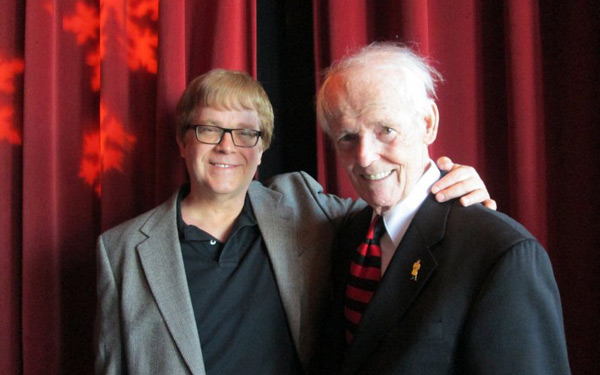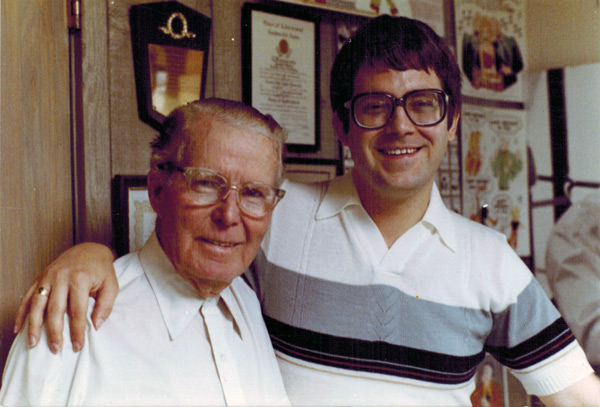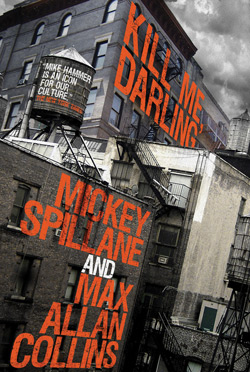Yesterday (Sunday, Feb. 22), in Woodstock, Illinois, Barb and I attended the intimate premiere of the documentary CHESTER GOULD: AN AMERICAN ORIGINAL written and directed by Tom and Steve Firak. The documentary, which is very good, was many years in the making and involved interviews with Gould family members as well as several of us who worked on the strip, as well as various experts and cartoonists, including Robert Crumb.
For the record, I am very well represented in the documentary, which any fan of comics (not just DICK TRACY) would find of great interest…ditto any student of popular culture. Chicago PBS has picked the documentary up, which had its on-air premiere the same afternoon as the event; WTTW will be showing it at various times over the next year. The Firaks plan a follow-up doc that will focus on Gould’s artwork and storytelling in more depth, utilizing more of their 200-plus hours of raw material.
The event was held at the Stage Left Café, which is attached to the historic (and beautifully restored) Old Opera House, where Orson Welles performed as a boy. (Woodstock events honoring Welles are coming up in May, one featuring my friend and collaborator, Brad Schwartz, whose book on the WAR OF THE WORLDS broadcast will soon be published.) The Old Opera House also served as the hotel in GROUNDHOG DAY – the town square of Woodstock will be familiar to anyone who has seen that film, which as I’ve said here before is one of my favorites. Woodstock, of course, is where Chester Gould lived and worked (well, five miles away in his country estate).
Filmmaker Tom Firak, who a while back shot extensive interview footage with me here in Iowa, invited us to attend. As regular readers of these updates may have gathered, I carry a certain amount of bitterness about the way my TRACY tenure abruptly ended. In recent years I have come to terms with that, and now realize that my situation is similar to Dean Martin saying his two biggest breaks were teaming with Jerry Lewis and splitting with Jerry Lewis. After all, shortly after a Tribune Syndicate editor (who I still cheerfully hate, except not cheerfully) fired me three months into my new contract period, I came up with ROAD TO PERDITION.
Gradually my love for DICK TRACY and my pride for my fifteen-plus years on the strip have returned to me, signaled by my serving as an editorial consultant and the regular writer of critical introductions to IDW’s series of the complete collected Chester Gould TRACY. Revisiting Chet’s work – a few stories I’m reading for the first time – has reminded me of just how outrageous a visual storytelling genius he was/is, and how much his storytelling technique has fused itself with my DNA.
The intimate gathering at the lovely café – perhaps seventy invited guests were there – included what could be described with a straight face (new TRACY villain! STRAIT-FACE!) as DICK TRACY royalty. These included such members of the Gould family as Chet’s daughter Jean and grandchildren Sue Sanders and Tracy O’Connell, as well as Rick Fletcher’s son Ross and other members of the Fletcher family. Also in attendance were Dick Locher and his wife Mary and Barb and myself. A number of us briefly spoke individually at the microphone before the documentary was shown.
Before and after the screening, I had lovely conversations with every member of the Gould and Fletcher family present. Warm memories flowed freely, and some old wounds were finally healed.
For those who came in late, Rick Fletcher was Chet’s final assistant who became my first artist on the strip. Dick Locher, Pulitzer Prize-winning editorial cartoonist, had been Chet’s assistant in the mid-‘50s and became my second artist after Rick’s passing in 1983. Both were men of great skill and accomplishment, with very different approaches to TRACY and my scripts. Reminiscing with Rick’s son Ross was a real pleasure – his father is, not surprisingly, obvious in his face – as was chatting with Tracy O’Connell, who bears a striking resemblance to his late grandfather. The afternoon was haunted by friendly ghosts.
For me, the best thing about the event was reconnecting with Dick Locher. We had not seen each other or spoken even on the phone for over twenty years. One day we were collaborators, the next day we were not. I wondered if our meeting would be awkward or perhaps stiff. Not the case. Dick was warm and affable – well, he always has been – but we connected in a way that only people who have been in the trenches together can. It was a delightful meeting between two Iowans – interestingly, Rick Fletcher was an Iowa boy, too – and one that I hope will be repeated. When he spoke at the mic, Locher told a wonderful story about Chester Gould having sent him home with a real machine gun as reference, tipping the Chicago cops to prank Dick by stopping him at the train station to ask what the wrapped-up package was. This got a huge laugh. Then I went to the mic and claimed to have written the story for him.
A lovely day, and some closure for me.

M.A.C. and Dick Locher
QUARRY’S CHOICE continues to get some very nice reviews. But J. Kingston Pierce, who may be the best friend the modern mystery/suspense genre has, has topped them all, writing a fine overview of the Quarry series, the likes of which has never before been done. It opens with an assessment of the hitman genre, and then moves specifically into my work, suggesting – accurately in my opinion – that I created the notion of a hitman helming a series.
Mystery writer Mike Dennis is also very kind to QUARRY’S CHOICE, here.
Finally, Urban Politico likes QUARRY’S CHOICE, too, but seems a little embarrassed about it….
M.A.C.

